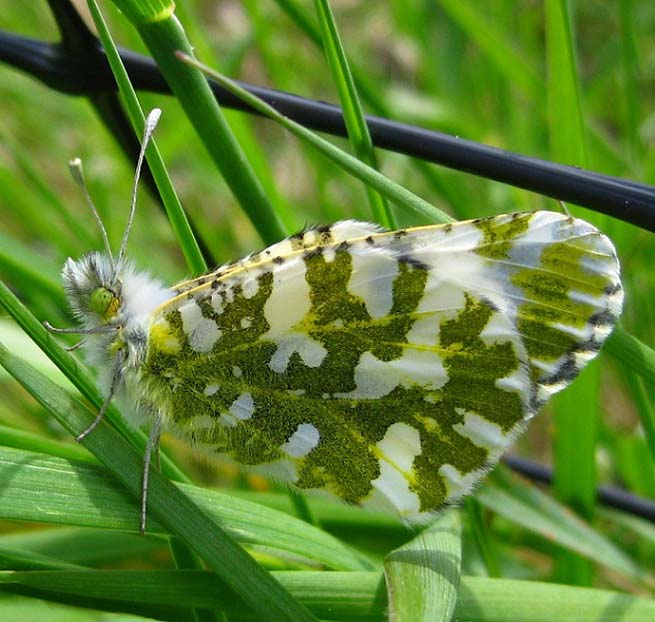— from Kayla Seaforth for San Juan County Land Bank —
Island Marble butterfly photo courtesy of WDFS
The green and white butterfly known as Island Marble (Euchloe ausonides insulanus) has been on the minds and lips of biologists, land managers and private landowners in the archipelago leading up to its listing as an endangered species this May. The butterfly is endemic to the San Juans, Vancouver Island and the Canadian Gulf Islands, though at present the only surviving population known is centered on American Camp, San Juan Island. The move to list the island marble as an endangered species opened up federal funding to support recovery efforts on San Juan and Lopez Island, and the U.S. Fish and Wildlife Service awarded the Land Bank a grant to set up an experimental habitat creation project at three of its preserves over the course of the next three years.
The project, designed by Land Steward Eliza Habegger, was conceptualized as a way to gather data on habitat creation methods that can be implemented on a small, landowner scale, at a relatively low cost without the use of specialty tools or equipment, and will provide the right density and phenology of the butterfly’s host plant, field mustard (Brassica rapa) to support the butterfly’s full lifecycle.
This methodology avoids tilling over the habitat patches, which has been the standard process to support ongoing field mustard growth to date. By using lower impact methods to achieve similar results, we hope that this will be a model to employ at sites where the soil is too thin or rocky to till, in situations where such equipment is not readily available, or in areas where surrounding remnant native prairie habitat would be compromised through such methods.
Over the next three years Land Bank staff and volunteers will experiment with the ”Moveable Feast” project design wherein small patches of grass are removed via solarization (installation of landscape fabric tarps), field mustard is seeded and protected from deer using several different fencing strategies, and density of mustard plants is monitored over the butterfly’s lifecycle. Because field mustard requires annual disturbance in order to thrive, we will start the process over again next season at each site, putting the “moveable” in “Moveable Feast.”
Staff began the site preparation work of lining out a grid of 25 plots, mowing tall summer grass and installing 5’x5’ squares of landscape fabric during the first week of July at Fisherman Bay Spit Preserve on Lopez Island and Zylstra Lake and Middlewood Preserves on San Juan Island. While both Zylstra Lake and Middlewood Preserves are closed to public access at this time, visitors to Fisherman Bay Spit can see the grid of black fabric squares in the preserve’s upland field now, and can anticipate seeing a deer fence installed by fall 2020. During the second and third years of this project Land Bank staff intends to host educational field trips for project partners and members of the public, so stay tuned for those dates!
To learn more about the island marble butterfly including lifecycle, distinguishing features, and how to get involved with habitat creation visit our friends at the San Juan Preservation Trust and Washington Department of Fish and Wildlife.
If you have questions about this project please contact elizah@sjclandbank.org or kaylas@sjclandbank.org.
**If you are reading theOrcasonian for free, thank your fellow islanders. If you would like to support theOrcasonian CLICK HERE to set your modestly-priced, voluntary subscription. Otherwise, no worries; we’re happy to share with you.**










The Land Bank does so much amazing work, often behind the scenes. The open space, forest lands, hiking trails and wildlife of our islands are among our most precious resources, and much is thanks to the Land Bank.
This is how we steward our planet and all our relations. So proud to be and off and on-again Islander..Thank you!